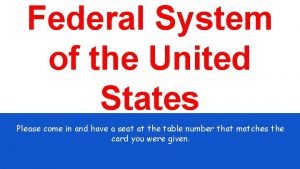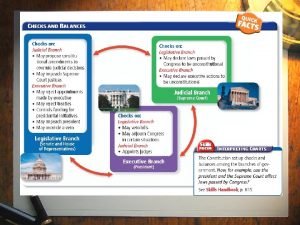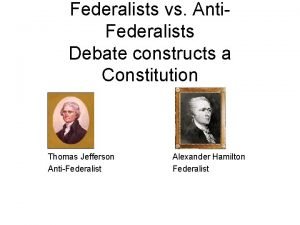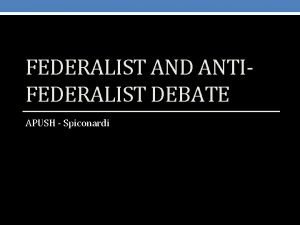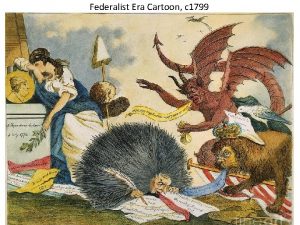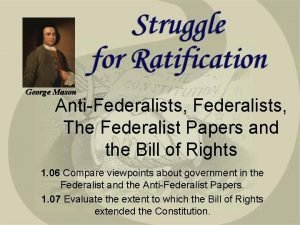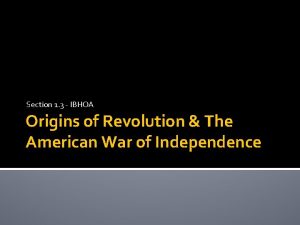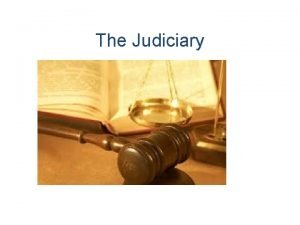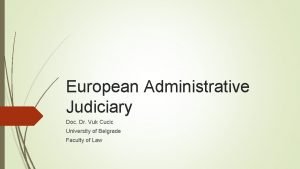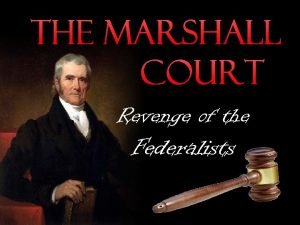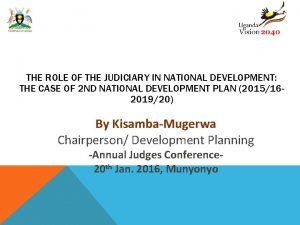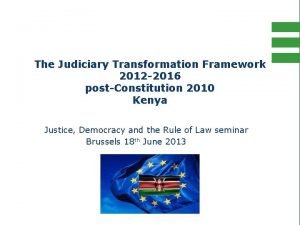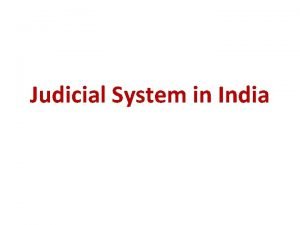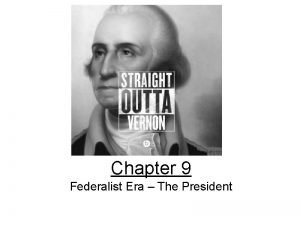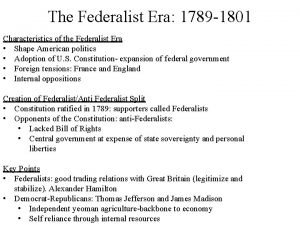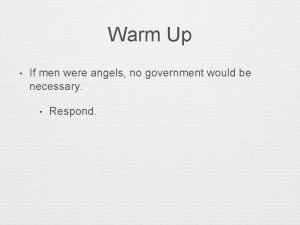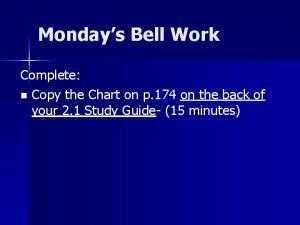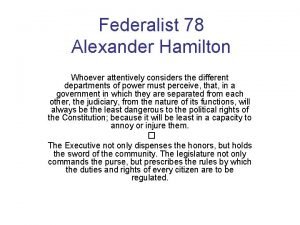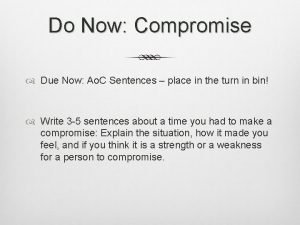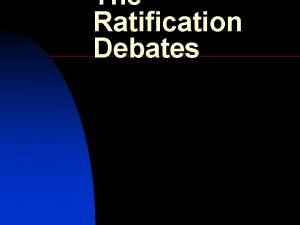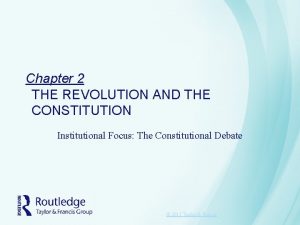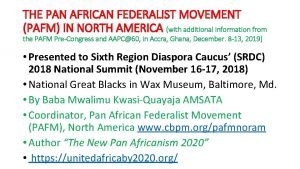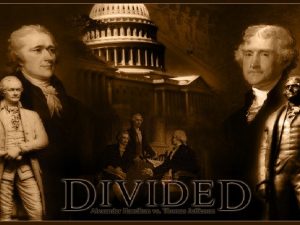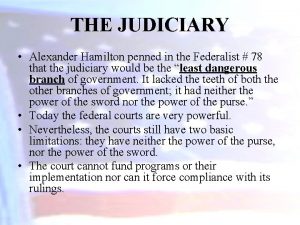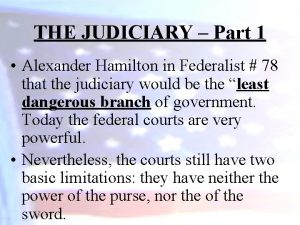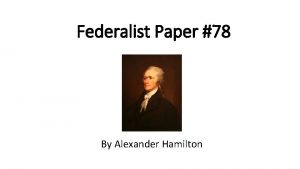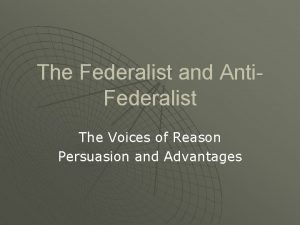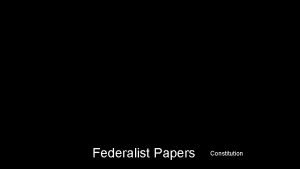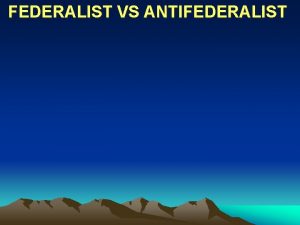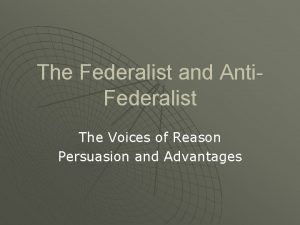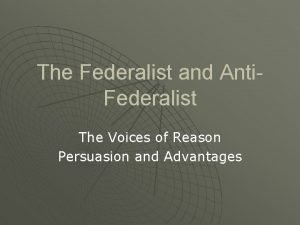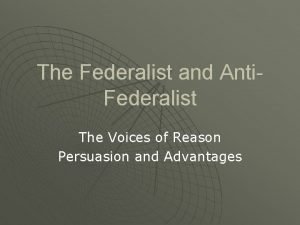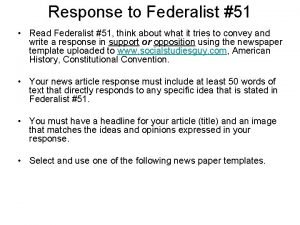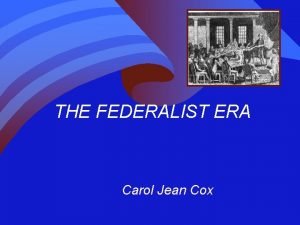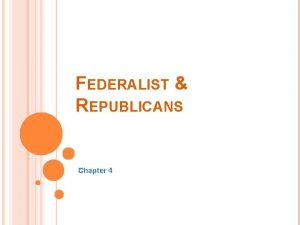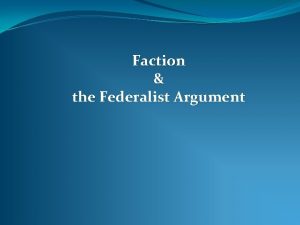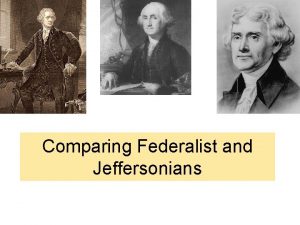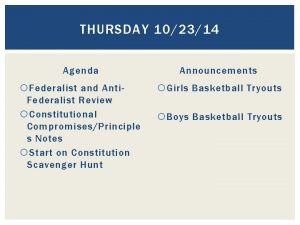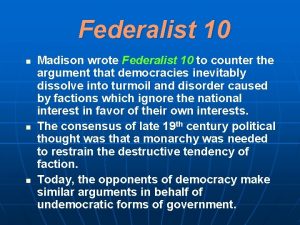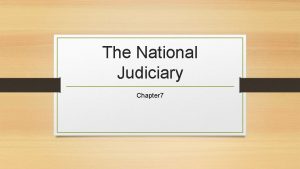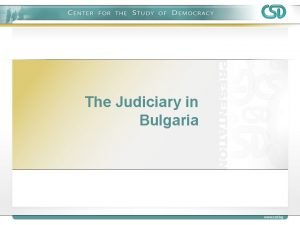The Judiciary Federalist Paper 78 Hamilton argues that


































- Slides: 34

The Judiciary

Federalist Paper 78 • Hamilton argues that an independent judicial branch is essential to the protection of liberty. • He implies that the Supreme Court has the power of judicial review (the power to overturn an executive action or law passed by Congress as unconstitutional).

Mode/Method of appointing judges-Checks & Balances • Federalist #76, #77 discussed Executive Power to appoint, Congress to ratify, #78 presumes same • Would President pressure Senate to support nominee? NO-Senate virtue • Would Senate have undue influence on President over appointments? NOPublic scrutiny

Tenure of Judges-Fed. 78 • Term continues during good behavior • Assures judicial independence, knowledgeable jurists + protects individual rights • Prevents invasions on judicial power by Executive/Legislature • U. S. has effective means of checking behavior

Structure of the Federal Courts - Constitutional Courts (lifetime tenure) • District Courts(94): the entry point for most litigation in federal courts, trial courts. • Courts of Appeal (13): review all final decisions of district courts. • Supreme Court: the final court of appeal. Sets its own agenda. – Legislative Court of Military Appeals & territorial courts

Map 16. 1 U. S. District and Appellate Courts Note: Washington, D. C. , is in a separate court. Puerto Rico is in the first circuit; the Virgin Islands are in the third; Guam and the Northern Mariana Islands are in the ninth. The Court of Appeals for the Federal Circuit, located in Washington, D. C. , is a Title 3 court that hears appeals regarding patents, trademarks, international trade, government contracts, and from civil servants who claim they were unjustly discharged. Source: Administrative Office of the United States Courts (January 1983). Copyright © 2013 Cengage

The Development of the Federal Courts n Slavery • President Jackson’s appointment of Chief Justice Roger B. Taney-succeeds Marshall 1836 • The Dred Scott case (1857): Said African Americans were not citizens, Missouri Compromise prohibiting slavery is unconstitutional • Public outcry and Civil War follow Copyright © 2013 Cengage

The Development of the Federal Courts n Government and the Economy • 1860’s– 1930’s: When can the economy be regulated by the states and when by the national government? • Private property and the 14 th Amendment -Life, Liberty, Property, contracts, corporations, etc. • 14 th and 15 th Amendments and the effect on African-Americans – narrow interpretations continue segregation. Copyright © 2013 Cengage

The Development of the Federal Courts n Government and Political Liberty • Supreme Court decisions-late 30’s more civil liberties, less economic questions • FDR’s “Court Packing Scheme” • Chief Justice Earl Warren- rise in judicial activism Copyright © 2013 Cengage

The Development of the Federal Courts n n The Revival of State Sovereignty • Supreme Court’s movements since the early 1990’s-less “interstate commerce” regulation, more decisions supporting states 11 th amendment had been ratified to prevent a citizen from suing a state in federal court and courts seem to embrace it in modern times • Supreme Court’s rendezvous with the new health care plan of 2010: Is the health care mandate interstate commerce thereby allowing federal gov’t to levy taxes? STAY TUNED Copyright © 2013 Cengage

Figure 16. 1 Economics and Civil Liberties Laws Overturned by the U. S. Supreme Court, by Decade, 1900– 2006 Note: Civil liberties category does not include laws supportive of civil liberties. Laws include federal, state, and local. Source: Harold W. Stanley and Richard G. Niemi, Vital Statistics on American Politics, 2007– 2008, 5 th ed. , p. 302 (Washington, D. C. : CQ Press, 2008). Reprinted by permission of CQ Press; a division of Congressional Quarterly, Inc. Copyright © 2013 Cengage

Selecting Judges • All federal judges are appointed by the president and confirmed by the Senate. • Senatorial courtesy allows a senator from the president’s party to reject a federal district nominee from his or her state.

Selecting Judges Presidents appoint nominees who share their political ideology. (Litmus Test? = Ideological Purity? )

Insulation from Public Opinion • Appointment process and life terms insulate justices from public opinion. • Justices deliberate in secret.

Jurisdiction • Original: where the case is heard first, usually in a trial. • Appellate: cases brought on appeal from a lower court.

The Jurisdiction of the Federal Courts n n Federal-question cases – Cases concerning the Constitution, federal laws, or treaties Diversity cases – Cases involving citizens of different states who can bring suit in federal courts Copyright © 2013 Cengage

Federal Jurisdiction • Dual Court System (state, federal) • Some cases that begin in state courts can be appealed to the Supreme Court. • Controversies between two state governments can only be heard by the Supreme Court.

Figure 16. 4 The Jurisdiction of the Federal Courts Copyright © 2013 Cengage

Getting to Court: Standing (authorization) to Sue • Sovereign Immunity: Can’t sue the gov’t without its’ consent • A party must demonstrate actual harm or a reasonable relation to the situation being challenged. • The Supreme Court is a court of concrete review (there must be an actual dispute), rather than a court of abstract review (involving a hypothetical dispute).

Getting to Court n n n In forma pauperis (for the poor) Fee Shifting-loser pays winner court costs Class Action Suits Carl Iwasaki/Time Life Pictures/Getty Images Linda Brown was refused admission to a white elementary school in Topeka, Kansas. On her behalf, the NAACP brought a class-action suit that resulted in the 1954 landmark Supreme Court decision Brown v. Board of Education, p. 455. Copyright © 2013 Cengage

Getting to Court: Writ of Certiorari“made more certain” • The “rule of four” requires agreement of four justices to hear the case • Involving significant federal or constitutional question • Involving conflicting decisions by circuit courts • Involving Constitutional interpretation by one of the highest state courts

The Supreme Court in Action n n n Brief – summarizes case Amicus curiae – friend of the court Per curiam opinion-brief, unsigned opinion of the court Opinion of the court-majority view Concurring opinion-agreeing w/ majority but w/ different reasons Dissenting opinion-disagreeing opinion from majority decision Copyright © 2013 Cengage

Judicial Review • Stare decisis-Let decision stand-based on prior cases/precedent • Power to find legislation to be unconstitutional is not enumerated but was implied by the founders • Already practiced in states & modeled in Britain • Designed not to increase judiciary but to limit legislature

Judicial Review • Defined: the power of the courts to declare laws unconstitutional • Over 160 federal laws have been declared unconstitutional • It is the chief judicial weapon in the checks and balances system.

The Development of Judicial Review • Marbury v. Madison (1803) – Chief Justice John Marshall concludes that judges have the power to decide whether acts of Congress, the executive branch, state laws, and even State Constitutions violate the US Constitution – Supreme Court justices have the final say about the meaning of the Constitution – This power to declare what the Constitution means and whether government actions violate the Constitution is know as JUDICIAL REVIEW

Premises of Judicial Review 1. The Constitution is a superior, paramount law that cannot be changed by ordinary means. 2. Acts of Congress, the Executive, and the States reflect temporary, fleeting views of what law is. 3. Acts of Congress, the Executive, and the States that conflict with the Constitution are not entitled to enforcement and must be disregarded. 4. Judges are in the best position to declare what the Constitution means. 5. Until recently “political questions” have been left to Executive & Legislative branches. 6. Remedy - Supreme court order declaring what actions must be taken to right a wrong

Arguments Against Judicial Review • Popular Sovereignty is represented in the Legislatures. Judicial Review disregards sovereignty of the people. • Judicial Review could lead to political turmoil if other branches or states to not follow the courts’ interpretations. • Judicial Review makes judiciary equal or even superior to legislatures, even though judges are not elected • All government officials take oath to consider constitutionality of their actions • Judges errors in interpretation cannot be corrected through voting, but only through amendments

Constitutional Interpretation • Strict construction/judicial restraint: judges are bound by the wording of the Constitution; judges are interpreters, not policy-makers. This is linked to “original intent. ” • Loose construction/Judicial activism: judges should look to the underlying principles of the Constitution, and this can result in new policy.

Arguments for Judicial Activism • Courts should correct injustices when other branches or state governments refuse to do so. • Courts are the last resort for those without the power or influence to gain new laws.

Arguments Against Judicial Activism • Judges lack expertise in designing and managing complex institutions. • Initiatives require balancing policy priorities and allocating public revenues. • Courts are not accountable because judges are not elected and serve life terms.

Checks on Judicial Power • Court has no “police” power; The president and states can ignore/evade decisions. • Congress confirms judges & can impeach judges for bad behavior • Congress can pass legislation limiting court decisions & jurisdiction

Checks on Judicial Power • Congress and the states can amend the Constitution (11 th amendment ratified to prevent a citizen from suing a state in federal court) • Congress can alter/repass laws found unconstitutional • Congress can alter the courts’ jurisdiction • Congress can change the number of

Public Opinion and the Courts • Defying public opinion may be dangerous to the legitimacy of the Supreme Court. • Impeachment and lack of enforcement powers mean justices are not completely isolated from public opinion.

Figure 16. 5 Patterns of Public Confidence in the Court, 1974– 2006 Source: The Gallup Poll. Copyright © 2013 Cengage
 Federalism cartoon explanation
Federalism cartoon explanation Federalist vs anti federalist quiz
Federalist vs anti federalist quiz Anti federalists vs federalists
Anti federalists vs federalists Federalists vs anti federalists apush
Federalists vs anti federalists apush Federalist cartoon
Federalist cartoon Was george mason a federalist
Was george mason a federalist The federalist paper
The federalist paper Federalist paper 78
Federalist paper 78 Jusicial restraint
Jusicial restraint Vuk cucic
Vuk cucic National agenda uae
National agenda uae Whats the judiciary act
Whats the judiciary act Department of judiciary
Department of judiciary Judicial transformation framework
Judicial transformation framework Judiciary system in india
Judiciary system in india Thơ thất ngôn tứ tuyệt đường luật
Thơ thất ngôn tứ tuyệt đường luật Con hãy đưa tay khi thấy người vấp ngã
Con hãy đưa tay khi thấy người vấp ngã Thơ thất ngôn tứ tuyệt đường luật
Thơ thất ngôn tứ tuyệt đường luật Tôn thất thuyết là ai
Tôn thất thuyết là ai Ngoại tâm thu thất chùm đôi
Ngoại tâm thu thất chùm đôi Walmart thất bại ở nhật
Walmart thất bại ở nhật Gây tê cơ vuông thắt lưng
Gây tê cơ vuông thắt lưng Block av độ 1
Block av độ 1 Tìm vết của đường thẳng
Tìm vết của đường thẳng Sau thất bại ở hồ điển triệt
Sau thất bại ở hồ điển triệt The federalist era lesson 3
The federalist era lesson 3 Anti federalist characteristics
Anti federalist characteristics Federalist 51 summary by paragraph
Federalist 51 summary by paragraph Federalist vs democratic republicans chart
Federalist vs democratic republicans chart Main points of federalist 78
Main points of federalist 78 Federalist 10 interest groups
Federalist 10 interest groups Anti federalist rap lyrics
Anti federalist rap lyrics Historical context of federalist #10
Historical context of federalist #10 Anti federalist beliefs
Anti federalist beliefs Pan african federalist movement
Pan african federalist movement
